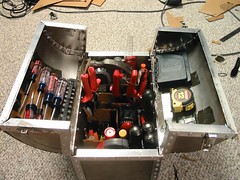Bringing back the morning numbers tweet
A long time ago (by Internet standards, anyway) I used to tweet out a bunch of financial indicators, in the days when I did a financial podcast. After making the move to Blue Sky Factory and the the world of email marketing, I lost touch with some of the day to day market numbers, and I’m finding that my ability to understand the world – especially the news headlines – is diminished.
So I’m bringing back the financial morning tweet, for my own benefit if not for everyone else’s. Every morning that I do #the5 (see this post for what #the5 is all about), I’ll do the numbers as well.
Now, if you’re not at all interested in financial data, this sort of tweet will be uninteresting. Just skip it.
Here’s what it will look like:
DJIA -81 SPX -11 VIX 40 TED 35.7 LIBOR91 51 OIS 22 MSCI 1074 BDI 3844 30yr 4.87 BCF 71.24 GLD 1183.40 RR 12.25 #econ
If you’re interested in financial data but have no idea what any of this means, let’s take a cruise through it.
DJIA: The Dow Jones Industrial Average. While it’s not the be-all/end-all of the state of our economy, the Dow is the most popular and well known indicator in the press and media, so it’s included for its psychological impact. Measured in dollars, and in the mornings, it’ll be listed as the futures, or what investors are predicting will happen the moment the markets open up.
SPX: The Standard & Poor 500. One of the better measures of the overall economy, the S&P 500 includes the stock prices of 500 companies from around the business nation. Measured in dollars, and in the mornings, it’ll be listed as the futures, or what investors are predicting will happen the moment the markets open up.
VIX: The Chicago Board Options Exchange Volatility Index. One measure of seeing how confident investors are. When the VIX is low (under 20), there’s not much volatility in the market. When the VIX is high (over 30), it means there’s a lot of volatility and not a lot of confidence. Measured in basis points; 100bp = 1%.
TED: The TED spread. This is the difference between 3 month Treasury bill rates and the 3 month LIBOR (London Inter-Bank Offered Rate). The TED spread indicates credit risk in the economy – when the spread is wide (more than 50), it means that the banking system is in trouble. Measured in basis points; 100bp = 1%.
LIBOR91: 91 day, or 3 month London Inter-Bank Offered Rate. LIBOR indicates the cost for banks to borrow from each other. LIBOR indicates how expensive money is to borrow, and higher LIBOR rates will correspond to higher borrowing rates for businesses and consumers. Measured in basis points; 100bp = 1%.
OIS31: 31 day or 1 month Overnight Indexed Swap rate. OIS measures how much liquidity – cash – is in the financial system. Higher OIS means less cash is in the system, while low OIS means lots of easy money is floating around. Measured in basis points; 100bp = 1%.
MSCI: The Morgan Stanley Capital International. The MSCI is an index of 1,500 world stocks from developed nations, giving a broad overview of the world’s corporate performance. As MSCI goes up, so do the world’s economies. Measured in dollars.
BDI: The Baltic Dry Index. BDI measure the cost of shipping bulk dry cargoes. This is important because unlike speculative investments, BDI measures the price of actual goods in transit. You don’t buy space on a cargo ship unless you have something you’re selling and shipping. Higher BDI indicates more demand for shipping and means the economy is growing. Measured in dollars.
30yr: The 30 year fixed mortgage rate as published by Bloomberg. The most standard kind of mortgage, mortgage rates go up when the cost of borrowing money goes up and vice versa. Measured in percentage points.
BCF: Brent Crude Futures, the price of a barrel of Brent crude oil. BCF tells you how expensive oil is on the market. Oil fuels your car, heats your house, and indirectly impacts consumer goods (since most everything is made of some plastic), as well as food prices – most fertilizer in agriculture is derived from oil. Interestingly enough, if you divide the BCF number by 25, you get roughly the price at the pump in a few weeks. Not a hard and fast rule, but a useful forward-looking indicator. Life gets more expensive when oil prices go up – but pollution and consumption goes down. Measured in dollars.
GLD: The price of a troy ounce of gold. Gold is one of the world’s benchmarks for inflation. As a currency inflates or as an economy deteriorates, people buy gold as a hedge, a way to protect themselves from loss. Gold itself isn’t really useful – it’s just a lump of metal – but it doesn’t lose physical mass sitting in a vault in the same way that a stock can lose value rapidly on speculation. Measured in dollars.
RR: Rough Rice. This is the world price of a bushel of rough rice, or rice just harvested from the fields. 20% of the nutrition of all humanity comes from rice, so when the price of rice goes up, it’s effectively a tax on the world. If the price of rough rice goes really high (above 15) you will see headlines in the world news about food shortages and hunger with greater frequency. Measured in dollars.
What does it all mean?
Individually, each indicator tells you something about how the world is doing financially. Some indicators tell you about banks and governments. Others tell you about commodities, raw materials, or corporations. Put together, they’re a very diverse view of the world economy and can even predict the future a little bit.
For me, I look at them to see how the world is doing. What’s in the headlines very often has financial underpinnings. If you know from these indicators what’s happening financially today, you’ll know what the news will be in a few days or weeks ahead.
If the price of oil skyrockets, you’ll see changes in the news and daily life. Seeing BCF spike now will tell you that those changes will be coming in 4-6 weeks as that barrel of oil eventually works its way into finished goods that consumers use.
Seeing the price of rough rice spike today and stay consistently high for a month will tell you that poor countries who are dependent on rice as a nutritional staple will be headed for famine if the price doesn’t come down.
Seeing the VIX skyrocket as it did a few years ago gave insiders advanced notice of the major stock market crashes long before the general public knew. Way back in the day, I saw the VIX leap above 30 and stay there in the summer of 2007. I dumped my entire retirement portfolio into a money market account in reaction to it. While I made almost no money in the following two years, I managed to completely avoid the market crash, too and saved my retirement from disaster.
I’d encourage you to not just pay attention to these numbers or tweets, but to also pick your own indicators, your own interpretation of what’s important in the world. You’ll know long before your friends and colleagues what’s going to happen if you study the numbers and learn what they mean.
Did you enjoy this blog post? If so, please subscribe right now!
Get this and other great articles from the source at www.ChristopherSPenn.com! Want to take your conference or event to the next level? Book me to speak and get the same quality information on stage as you do on this blog.





 I’ve been in the market for an arborist – a tree professional that can take care of some dead wood and pruning in my yard on some very old trees. I’m far more capable when it comes to pruning databases than I am dogwoods, so I solicited bids from local arborists.
I’ve been in the market for an arborist – a tree professional that can take care of some dead wood and pruning in my yard on some very old trees. I’m far more capable when it comes to pruning databases than I am dogwoods, so I solicited bids from local arborists. … but that’s not enough. What you need on your side are champions. Not athletes, but in the truest medieval sense of the ideal, knights who will step up to battle for your cause. Bear in mind, we’re not talking about armed physical combat (but boy, wouldn’t that shut some critics up really fast), but having champions who are well-respected members of their community defend you in that court of public opinion.
… but that’s not enough. What you need on your side are champions. Not athletes, but in the truest medieval sense of the ideal, knights who will step up to battle for your cause. Bear in mind, we’re not talking about armed physical combat (but boy, wouldn’t that shut some critics up really fast), but having champions who are well-respected members of their community defend you in that court of public opinion.

 From one perspective, it’s the most real thing in the world. Without it, you don’t eat, you don’t have a place to live, no clothes to wear, etc. unless you’re living out in the wilderness, foraging off the land. Money can be a tremendous amplifier of personal power. With an inexhaustible supply of money, you could solve world hunger, cure disease, and end conflict.
From one perspective, it’s the most real thing in the world. Without it, you don’t eat, you don’t have a place to live, no clothes to wear, etc. unless you’re living out in the wilderness, foraging off the land. Money can be a tremendous amplifier of personal power. With an inexhaustible supply of money, you could solve world hunger, cure disease, and end conflict.
